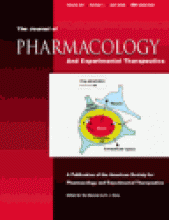Abstract
The present study explored the possibility that excitatory amino acid (EAA) sensitivity within the ventral pallidum (VP) is altered by long-term removal of dopamine (DA). Electrophysiological experiments were conducted in chloral hydrate-anesthetized rats 21 to 28 days after they received unilateral substantia nigra injections of the dopaminergic toxin 6-hydroxydopamine (6-OHDA). VP neurons increased firing at low microiontophoretic ejection currents of the EAA agonistsN-methyl-d-aspartate (NMDA) and α-amino-3-hydroxy-5-methylisoxazole-4-propionic acid (AMPA); however, high currents decreased action potential amplitude and rapidly caused cessation of neuronal firing. These responses likely reflected the induction of depolarization block for they were reversed by coiontophoresis of the hyperpolarizing transmitter γ-aminobutyric acid (GABA) at ejection current levels that normally suppressed firing. The ability of NMDA and AMPA to induce such inactivation was greater in the VP of 6-OHDA-lesioned hemispheres, but unchanged in reserpinized rats, verifying that the alterations in responding to NMDA were the result of chronic, rather than acute, DA removal. The adaptations do not appear to be the consequence of a diminished GABAergic tone for the ability of bicuculline to increase firing (due to blocking a tonic GABAergic input) was not changed. However, low ejection currents of GABA that were insufficient to alter firing rate greatly attenuated the ability of NMDA to induce an apparent depolarization inactivation when coiontophoresed with NMDA onto VP neurons of the lesioned, but not the unlesioned, hemisphere. These studies show that chronic DA removal altered the EAA-induced amplitude-decreasing (i.e., the apparent depolarization inactivation) effects in VP neurons in the absence of a decrease in GABAergic tone.
Footnotes
-
↵1 Present address: Department of Neurology, Reed Neurological Research Center, UCLA School of Medicine, Los Angeles, CA 90095.
-
This work was supported by U.S. Public health Service Grant MH11607 (to M.S.T. and T.C.N.), and by the M.D./Ph.D. and Neuroscience graduate programs at Loyola University Chicago.
- Abbreviations:
- EAA
- excitatory amino acid
- PD
- Parkinson's Disease
- DA
- dopamine
- STN
- subthalamic nucleus
- GPi
- internal segment of globus pallidus
- VP
- ventral pallidum
- NMDA
- N-methyl-d-aspartate
- AMPA
- α-amino-3-hydroxy-5-methylisoxazole-4-propionic acid
- GABA
- γ-aminobutyric acid
- 6-OHDA
- 6-hydroxydopamine
- HPLC-EC
- high-performance liquid chromatography with electrochemical detection
- ANOVA
- analysis of variance
- ISI
- interspike interval
- CNQX
- 6-cyano-2,3-dihydroxy-7-nitroquinoxaline
- AP-5
- 2-amino-5-phosphopentanoic acid
- GPe
- external segment of globus pallidus
- Received August 30, 2001.
- Accepted January 8, 2002.
- The American Society for Pharmacology and Experimental Therapeutics
JPET articles become freely available 12 months after publication, and remain freely available for 5 years.Non-open access articles that fall outside this five year window are available only to institutional subscribers and current ASPET members, or through the article purchase feature at the bottom of the page.
|






